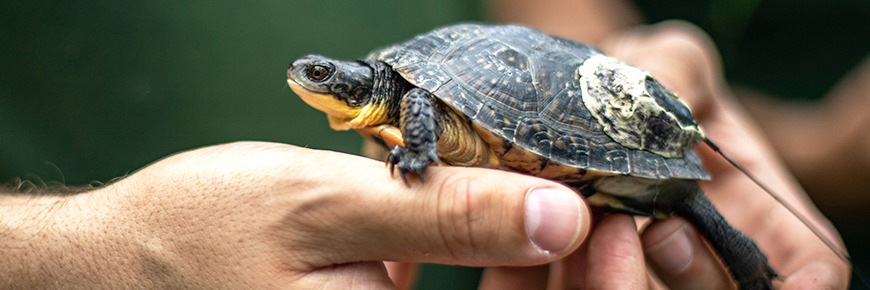
Closed but still Caring
Rouge National Urban Park
Getting the 2020 Cohort of Blanding’s Turtles Ready to be Released into RNUP

Prior to 2014, as few as 7 Blanding’s turtles remained in Rouge National Urban Park (RNUP). To help increase the population of this species, Parks Canada and the Adopt-A-Pond Wetland Conservation Program at the Toronto Zoo began a long-term Blanding’s turtle reintroduction project. Turtles that are part of this head start program are hatched at the Zoo and released into the park when they are a little older to minimize threats, such as nest destruction and predation. Together, along with several other partners, we have released 339 baby Blanding’s turtles into RNUP, and that number is about to increase.
Despite facility closures due to COVID-19, conservation projects continue and Parks Canada and the Toronto Zoo are preparing to release more head start Blanding’s turtles into the park this year. These turtle eggs are collected from nests in Ontario that are vulnerable to destruction, for example if they were made along roadsides. The turtles also go through genetic testing to ensure a strong genetic population is being released into the Rouge. Currently, the Zoo is caring for 51 hatchlings and 59 turtles that are between one and two years of age.
How are the turtles cared for at the Zoo?
For most of the year, the Blanding’s turtles are kept indoors in the Zoo’s Wildlife Health Centre. Each tank has a lot of swimming space, with areas available for basking under a heat lamp, and plants for the turtles to practice hiding. In the summer, the turtles are moved to an outdoor area where they’re put into larger tanks with a similar setup, but natural basking platforms, like driftwood, are included so the turtles can practice basking on natural material. Rather than heat lamps, the turtles get to bask in the sun as they would in their natural habitat.
The turtles are fed in the morning, three days per week. After that, their tanks are cleaned and their water gets changed. They receive kale as part of their diet to practice biting and tearing their food. The turtles are also weighed and measured monthly to monitor their growth. Zoo staff try not to disturb the turtles too much so they don’t get comfortable with humans or associate them with food.
Caring for the turtles is a team effort requiring many different players. Nutritionists prepare and distribute the turtles’ food. The Zoo’s Americas pavilion keepers take care of the hatchlings, while there is one dedicated staff member who takes care of the older Blanding’s turtles being prepared for release in June. She sometimes receives help from other staff and high school co-op students. Other Wildlife Health Centre staff check in on the turtles on the weekend, and the Lead Keeper of Reptiles and Amphibians helps out when needed. Maintenance and utility staff of course keep their lights and pumps going; the list goes on!
How are the turtles prepared to be released?
As the turtles get older, and closer to release, their food becomes less processed. When they’re hatchlings, they need bite-sized pieces, but later they get whole foods such as worms so they can practice tearing their food. A few weeks before their release, they are transferred to an outdoor area to acclimate to day/night cycles and daily temperature fluctuations.
Each turtle is given a notch on their shell when they’re born so the Zoo staff can identify all of the individual turtles. These notches become less obvious over time, so each turtle is also given an internal microchip before they are released, just like your pets get a microchip! Some turtles also get a transmitter so that Adopt-A-Pond staff can monitor them after they are released.
When will the turtles be released?

Each year, the Blanding’s turtles are released into RNUP at the end of June to coincide with National Indigenous Peoples Day. Turtles are a culturally significant species to the First Nations people of Ontario, especially the Blanding’s turtle which has a story of how it obtained its yellow chin. A turtle also plays a key role in the creation story, where it holds the Earth on its back, leading First Nations people to call North America "Turtle Island". To find these stories and more, please see the Zoo’s Turtle Island Conservation page.
To see behind the scenes footage of how the turtles are fed at the zoo, watch this YouTube video from the Toronto Zoo.
Related links
- Date modified :